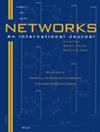A survivable variant of the ring star problem
IF 1.3
4区 计算机科学
Q4 COMPUTER SCIENCE, HARDWARE & ARCHITECTURE
引用次数: 0
Abstract
Abstract The Ring Star Problem consists in selecting a subset of nodes called hubs including the depot and linking them with a cycle, the remaining nodes being connected to exactly one hub, at minimum cost. We study a survivable variant of the Ring Star Problem where at most one node in a given subset of so‐called uncertain nodes can fail if selected as a hub. We model this problem as an Integer Linear Program (ILP), that is also addressed with a Branch‐and‐Benders‐cut decomposition. The Benders subproblem is turned into a linear program with the addition of new inequalities that are shown to be facet‐defining, and several enhancements to both the ILP and Branch‐and‐Benders‐cut algorithm are also presented. Both approaches are compared on the basis of extensive numerical experiments that bring the following conclusions. First, the survivable variant is shown to be much harder than the original Ring Star Problem, and the extra cost induced by survivability is significant. Second, the ILP formulation tends to produce tighter lower bounds but memory issues are frequent for large instances. Finally, the Branch‐and‐Benders‐cut algorithm returns feasible solutions that are often of better quality than those produced by ILP, and is less frequently subjected to memory issues on the considered set of instances.环状恒星问题的一个可存活的变体
环形星问题包括选择一个称为集线器的节点子集,包括仓库,并将它们与一个循环连接,其余节点以最小的成本恰好连接到一个集线器。我们研究了环星问题的一个可生存变体,其中在给定的所谓不确定节点子集中最多有一个节点在被选为集线器时可能失效。我们将此问题建模为整数线性规划(ILP),也可以用分支和弯刀分解来解决。通过添加新的面定义不等式,将Benders子问题转化为一个线性规划,并对ILP和Branch - and - Benders - cut算法进行了一些改进。在大量数值实验的基础上,对两种方法进行了比较,得出以下结论。首先,可生存的变体比原来的环形星问题要困难得多,并且由可生存性引起的额外成本是显著的。其次,ILP公式倾向于产生更严格的下界,但对于大型实例来说,内存问题很常见。最后,Branch - and - Benders - cut算法返回的可行解通常比ILP生成的解质量更好,并且在考虑的实例集上较少受到内存问题的影响。
本文章由计算机程序翻译,如有差异,请以英文原文为准。
求助全文
约1分钟内获得全文
求助全文
来源期刊

Networks
工程技术-计算机:硬件
CiteScore
4.40
自引率
9.50%
发文量
46
审稿时长
12 months
期刊介绍:
Network problems are pervasive in our modern technological society, as witnessed by our reliance on physical networks that provide power, communication, and transportation. As well, a number of processes can be modeled using logical networks, as in the scheduling of interdependent tasks, the dating of archaeological artifacts, or the compilation of subroutines comprising a large computer program. Networks provide a common framework for posing and studying problems that often have wider applicability than their originating context.
The goal of this journal is to provide a central forum for the distribution of timely information about network problems, their design and mathematical analysis, as well as efficient algorithms for carrying out optimization on networks. The nonstandard modeling of diverse processes using networks and network concepts is also of interest. Consequently, the disciplines that are useful in studying networks are varied, including applied mathematics, operations research, computer science, discrete mathematics, and economics.
Networks publishes material on the analytic modeling of problems using networks, the mathematical analysis of network problems, the design of computationally efficient network algorithms, and innovative case studies of successful network applications. We do not typically publish works that fall in the realm of pure graph theory (without significant algorithmic and modeling contributions) or papers that deal with engineering aspects of network design. Since the audience for this journal is then necessarily broad, articles that impact multiple application areas or that creatively use new or existing methodologies are especially appropriate. We seek to publish original, well-written research papers that make a substantive contribution to the knowledge base. In addition, tutorial and survey articles are welcomed. All manuscripts are carefully refereed.
 求助内容:
求助内容: 应助结果提醒方式:
应助结果提醒方式:


